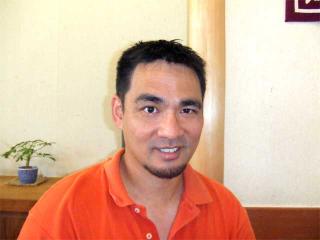Thursday, August 11, 2005
Lunch with Michiyasu
After some phone tag and missed opportunities, I finally managed to get in touch with Michiyasu and we agreed to meet for lunch. It has been a decade since we last me, and we had a lot of catching up to do.
When I was a student back in the 1990s, we used to go out on the town together a lot. I remembered Mitch as being one of the most outspoken Japanese I had ever met, and he is quite the individualist. I think he should've been born in the U.S., as his outspokeness had the potential to grate on other Japanese and would've fit in much better into American society. Times have changed and he has learned to adapt to Japanese society. He has become a family man, with a wife and kids, and works hard at two jobs to support them. At first, he seemed like he had turned into your stereotypical Japanese man, and we found it hard to talk, but after some time, we began to warm up, and it was like old times again as the conversation flowed freely. He is a hard worker, and is utterly devoted to his family. And yes, he is still a huge fan of American football! There is a Pittsburgh Steelers fan in Hiroshima.
Sunday, August 07, 2005
Meeting John and another late-night stroll

(Written after the fact, from my home office in Honolulu Hawaii)
Met John today. Now this man has lived an interesting life, 20 years in the marines and then retired. For the past several years, he shuttles back and forth between Hiroshima and Hawaii, in Japan during the summer, and Hawaii during the winter. The base at Iwakuni is nearby Hiroshima, and there are many military facilities in Hawaii, so he can get free medical and dental care, and can buy goods at the PX.
Boy is he a popular person! Passers-by on the street occasionally kept waving at him, as if he were a famous celebrity. When I asked John, he said they were friends saying “Hi”. I have never met anyone this popular before! The secret? In America he would be just another old man living on his pension. But at the International Center, Japanese come up to him to practice English, and he has a whole bunch of friends. He told me it is a good feeling to have people say hi to you on the street. Indeed, he is a bigger part of a community in Japan than in America. What gives? Why do Americans treat our seniors this way?
Also, he meets so many Japanese at the Hiroshima International Center because they like to practice their English with him. This is a place established by the government for foreigners to hang out and meet Japanese. There's free newspapers to read, the TV is set to CNN, free classes in Japanese run by volunteers, and (when I was there last year), free Internet accesss! I laugh when uninformed people tell me that Japanese are so xenophobic - yes, Japan does have its share of anti-foreign sentiment, but do we treat our foreigners in America this well? Hawaii needs an International Center. We need to give seniors a way to meet other people and be involved with society. And so many international students need a place to hang out and meet other Internationals and locals. If we had an International Center, we could have senior citizens meet up with exchange students who want to meet Americans and practice their English. And Americans could practice their foreign languages. And we would have far less lonely people around.
Cartoons are everywhere. This bus advertises "Chicken Ramen." Why eat ramen made from the bodies of cute chickens, I don't know...
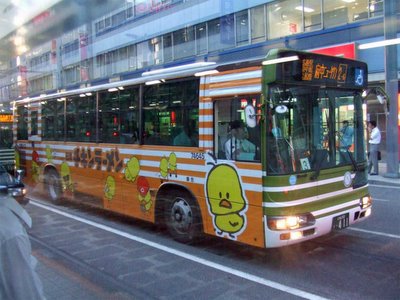
Once again, I went late night to an Internet cafe. I worked so late and had so much email to read, but look at how nice this place is. You have all these comics on the wall you can read, and all the soft drinks and coffee you can drink. Lots of videogame connetions for serious online gamers.

Being addicted to the Internet, I finished at around 2:00 am, and on the way home, got spooked by the total lack of people around the station area, except for a few angry looking cab drivers. Remember, this is the central train station in a major city in Japan!

So I asked a police officer who was sweeping the street (yes, that is the duty of a police officer), if it was safe to go through the station's underground pass, where you could see homeless people sleeping. He gave me a strange look and said, “of course.” I walked through the sleeping people and through the underpass. Here’s a picture and remember, this is close to 3:00 am at night in a major city, and not a soul in sight! I made it back safely. Of course, I would not recommend that other foreigners go strolling around in the dead of the night, and that I did this only because I blend into the background because I look Japanese, and of course, am physically bigger and stronger than most men here. Still, it made me wonder: are Americans that paranoid, or are Japanese that naive?
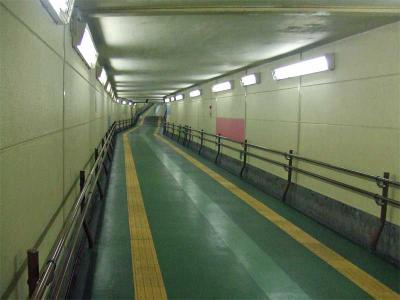
Saturday, August 06, 2005
Battleship Yamato Museum in Kure
Now you get a very different interpretation of the war than at the Peace Park. For one, you saw tons of models of Japanese navy ships. Then, this exhibit went into great detail about Japan’s wars: Sino-Japanese war, Russo-Japanese war, World War I, the Sino-Japanese War beginning in 1937, and then the Pacific War (what Japanese call the war with America, the British, and the Dutch). In a sense, this was the missing half of the Hiroshima Peace Park museum, which only focused on the suffering of the Japanese. But the interpretation of the war was more right-wing: the war was a quite justifiable affair. It focused on how Japan was continuously encircled by the West, and in order to avoid being colonized, it decided to take establish an empire in China, an action no different from what other Western nations were doing in Asia.
Also this museum does glorify the cult of the suicide warrior. The Yamato was sent out on a final tokko, or “special attack” (Japanese euphemism for “suicide mission”) in April of 1945: go to Okinawa without air cover and attack the invading American forces. With a small armada of escort ships, it went off to Okinawa, but never even made it far from the Japanese archipelago. Wave after wave of American planes picked off the escort ships, and continually rained bombs upon the Yamato, sending it to the bottom of the sea. Several thousands died and only a few hundred survived. This fits in with Japanese samurai movies, where the hero makes a doomed final attack, and is slowly cut down to pieces by masses of the enemy, but valiantly keeps charging forward until he dies. If you’ve watched the Last Samurai, you know what I mean. Anyway, here are some artifacts from the wreck of the Yamato salvaged via a deep sea submsersible like the one that explored the Titanic.

Little known among most people, even historians, is that a Japanese-American served aboard the Yamato. A Japanese author, who survived the Yamato’s final suicide mission, made reference to this point: the Nisei (second-generation Japanese American) was in Japan when the war was started and so he was drafted to listen to American radio intercepts. But because he was born in America, the Japanese sailors mercilessly bullied him and the author could hear the Nisei crying himself to sleep.
After seeing a memorial wall with the names of the Yamato dead, we then went to the other parts of the museum, a children’s museum, and then the fun part: the comics! We came upon a display for the cartoonist Matsumoto Leiji (why he used an “L” instead of an “R” I do not know). In the 19970s, he wrote Uchu Senkan Yamato, a sci-fi series about a spacecraft based on the battleship Yamato, complete with gun turrets and all.
In the conclusion of the series, the Yamato makes a suicide attack against the enemy, ramming itself (after most of the crew has one by one heroically died in combat) into the enemy spaceship, thus saving all of Earth. Hmmm...doesn`t it sound like the final mission for the real-life Yamato? This cartoon was reborn in the U.S. as Starblazers, heavily re-edited to strip away the Japanese military nuances of the film, and with an English version of the Yamato cartoon song (that sounds like some Japanese march): "We`re ooofff to outer space, we're leaving mother earth, to save the human race..."(Yes, click on the link. You'll hear a .mp3 of the theme song). BTW, here's a link to the Japanese version of the song. For some reason, it sounds less militaristic than the American version. A remix perhaps?
Afterwards, we went to a yatai street stall for some gyoza dumplings and ramen. Here is some oden, boiled goodies you can pick and choose. The customers at the stall were so funny. One older man, quite drunk, kept rambling about something. Despite all my Japanese language traiing, I could barely understand what he was saying. Kazuhiro told me not to worry as he could not understand either. Everyone was cracking up at what the man was saying. I asked to take his picture, and so he told me, “Do not show police” in Japanese and then took off his shirt! Then he posed for me with the yatai stall owner. So who made up the myth about Japanese being straight-laced and conformist?
The customers at the stall were so funny. One older man, quite drunk, kept rambling about something. Despite all my Japanese language traiing, I could barely understand what he was saying. Kazuhiro told me not to worry as he could not understand either. Everyone was cracking up at what the man was saying. I asked to take his picture, and so he told me, “Do not show police” in Japanese and then took off his shirt! Then he posed for me with the yatai stall owner. So who made up the myth about Japanese being straight-laced and conformist?
And then, another shock. I asked the woman next to us if I could take a picture of her and her boyfriend’s tattoos. We had made small talk earlier. And then, only after I took her picture and was about to leave, did she spoke to me in very fluent killer English! Now why didn’t she just speak to me in English earlier? Other foreigners complain that the Japanese always talk to them in English. Me, being a kakure gaijin (hidden foreigner), people seem hesitant to talk to me in English, even when they find out I am an American. So sometimes I end up talking to people in Japanese, and only deep into the conversation do they even let on that they are fluent in English. Is this some kind of test of my Japanese ability?I found out from our conversation what she originally hailed from Osaka. When I left, I could hear the other customers compliment her on her English. Now she’s not yakuza, but simply has a very beautiful tattoo, which she kindly let me photograph. She learned the English while in college and from her foreign friends.
Other foreigners complain that the Japanese always talk to them in English. Me, being a kakure gaijin (hidden foreigner), people seem hesitant to talk to me in English, even when they find out I am an American. So sometimes I end up talking to people in Japanese, and only deep into the conversation do they even let on that they are fluent in English. Is this some kind of test of my Japanese ability?I found out from our conversation what she originally hailed from Osaka. When I left, I could hear the other customers compliment her on her English. Now she’s not yakuza, but simply has a very beautiful tattoo, which she kindly let me photograph. She learned the English while in college and from her foreign friends.
Her boyfriend also pulled down his shirt to reveal a tattoo. Again, who says the Japanese are shy conformists? Like I said, you never know who can speak English in this nation! The people you think can speak, like professionals, cannot speak, and the people you least expect to speak, are the most fluent.
Like I said, you never know who can speak English in this nation! The people you think can speak, like professionals, cannot speak, and the people you least expect to speak, are the most fluent.
Nightime ceremony for the A-bomb victims
 At dinner, we watched TV and saw that there was a huge orchestra concert at the Peace Park, and saw tons of people. We decided to wait a little rather than brave the crowds again. Aunty was finally willing to pose for a picture.
At dinner, we watched TV and saw that there was a huge orchestra concert at the Peace Park, and saw tons of people. We decided to wait a little rather than brave the crowds again. Aunty was finally willing to pose for a picture.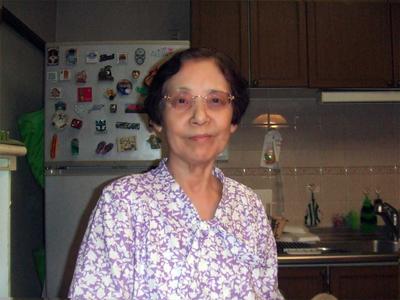
Kazuhiro and I caught the bus and we went back to the Peace Park. Then we went to float lanterns for the dead down the river. Huge crowd of people, but a bit more relaxed than in the morning. A-bomb dome bathed in a ghostly white light. I bought a lantern and wrote messages of peace on it.
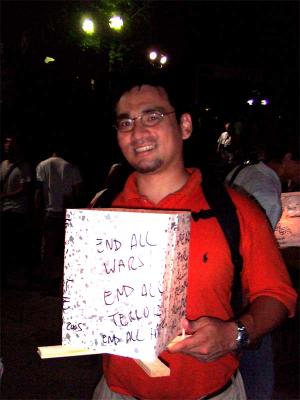 I floated my lantern at the rivers edge. All the lanterns representing the souls of the victims – a beautiful but bittersweet sight as the lanterns flowed upriver (high tide, so river went up)
I floated my lantern at the rivers edge. All the lanterns representing the souls of the victims – a beautiful but bittersweet sight as the lanterns flowed upriver (high tide, so river went up)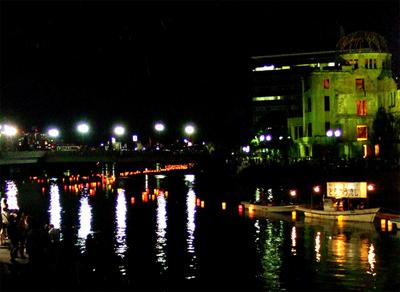
On the banks of the river, musicians were performing for peace.
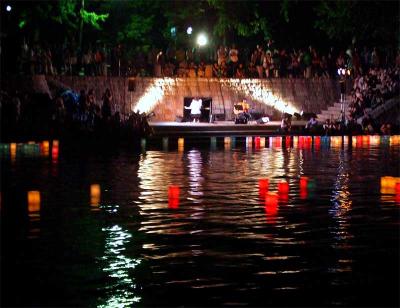 One jazz pianist came and performed an agitated version of “My favorite things.” He then played a peaceful and beautiful rendition of “When you wish upon a star.” Again, note the preponderance of Western music. I did see groups of foreigners talking to Japanese youth. We do need more times like this to build grass-roots international exchanges.
One jazz pianist came and performed an agitated version of “My favorite things.” He then played a peaceful and beautiful rendition of “When you wish upon a star.” Again, note the preponderance of Western music. I did see groups of foreigners talking to Japanese youth. We do need more times like this to build grass-roots international exchanges.I would like to see Hawaii do a similar peace festival. Think about it, we see general public demonstrations like parades with military equipment. But no peace demonstrations sponsored by the government. I would like to see a ceremony for A-bomb victims, with a booth on the side explaining Japan’s war of aggression against Asia, details of why the U.S. government decided to drop the bomb (many generals and advisors against doing so) and the legacy of the bomb. Keep anti-American sentiment to a minimum, and focus on the need for peace – that war is only truly a last resort. Have songs by artists to reinforce the message on the need for peaceful solutions to problems.
Later that night, I took Kazuhiro to the Shack to experience an American-style bar and grill, and to play darts. Along the way, I bumped into John, a retired Marine who I met ten years ago. He shuttles between Hiroshima and Honolulu. We agreed to meet on Monday.
 And of course, like almost all Japanese, the waitress at the Shack remembered me from last time. Aren`t the people here just memory machines? Or are nikkei so rare over here? Kazuhiro's hands trembled when he took this picture, so I used the computer to sharpen the photo. What a shame since the waitress was quite cute and friendly...
And of course, like almost all Japanese, the waitress at the Shack remembered me from last time. Aren`t the people here just memory machines? Or are nikkei so rare over here? Kazuhiro's hands trembled when he took this picture, so I used the computer to sharpen the photo. What a shame since the waitress was quite cute and friendly... 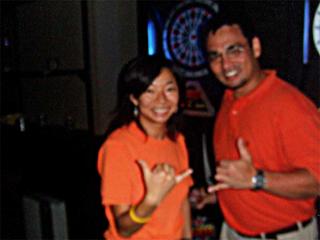
I was shocked as how so many westerners, especially women, were lighting up their cigarettes while they drank. Makes you wonder if all that anti-tobacco education just cannot defeat the glamorous portrayals of cigarettes in the movies. I also realized that people in the West do suffer from an obesity problem – saw so many young western women (including Asian Americans) with protruding guts in this bar. I guess I have been in Japan too long and used to seeing petite people. Middle-aged women, I understand, as gaining weight is part of growing older. But young western women of all races in their twenties being bigger than most Japanese young men? Mission control, we have a problem...
My darts aim has just deteriorated! Anyway, here`s Kazuhiro with a Budweiser:

60 anniversary of the bomb part 1
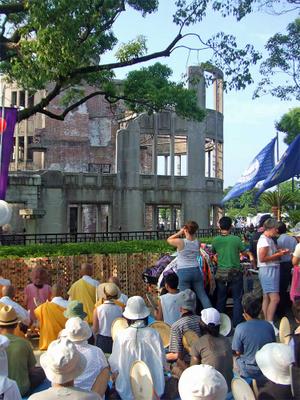
I somehow managed to wake up at 7:00 pm. The train station was just packed, I mean packed with school kids and foreign tourists on an excursion to go to the Peace Park. And what a sensory overload upon arriving. Saw zengakuren student activists shouting slogans, Buddhist priests chanting before the A-bomb dome, lots of people and school kids with petitions (for what, I do not know), riot police on standby, and just hoards of people, surprisingly many of them foreigners, walking to the Dome.Here are the student activists:
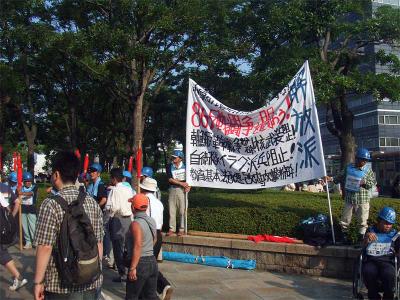
And here are the riot police standing nearby in case the small group of activists decided to emulate their breatheren in the West...

Just too many people at the ceremony. They had set up a tent to handle the overflow of crowds, but the crowd spilled way past the tents.
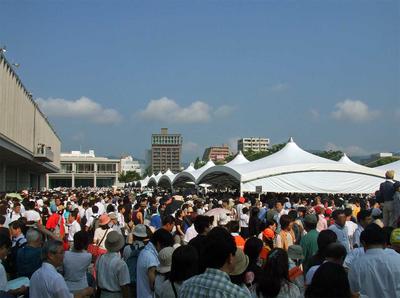 I could have stood way in the back to strain for a glimpse of the ceremony, but would have been in the unbelievably hot sun, not to mention muggy weather.Here is my view of the scene, if I was 6 and a half feet tall...(I held the camera way over my head).
I could have stood way in the back to strain for a glimpse of the ceremony, but would have been in the unbelievably hot sun, not to mention muggy weather.Here is my view of the scene, if I was 6 and a half feet tall...(I held the camera way over my head).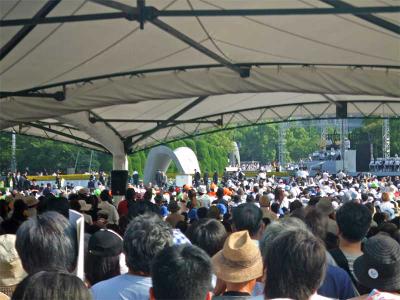 So I stood in the shade of the Peace Memorial Museum, far away from the festivities. Then the moment of silence at 8:15 followed by the release of doves. There were more speeches and such, but rather than broil in the sun, I just chatted with people around the park. For example, I met American Zen disciples from Oregon. The one I met in the morning needed help with translation – was there a locker somewhere?
So I stood in the shade of the Peace Memorial Museum, far away from the festivities. Then the moment of silence at 8:15 followed by the release of doves. There were more speeches and such, but rather than broil in the sun, I just chatted with people around the park. For example, I met American Zen disciples from Oregon. The one I met in the morning needed help with translation – was there a locker somewhere? He carried pictures of jizos and spread them around. We talked a little and found out that the temple was in Astoria, and that he used to live on Powell Street in Portland.
He carried pictures of jizos and spread them around. We talked a little and found out that the temple was in Astoria, and that he used to live on Powell Street in Portland.(Later in the evening, I met another Zen disciple from Oregon. He told me that one of the purposes of the trips was to meet the people who were the enemy. Then once you humanize the enemy, you can never want to go to war against them again.) He also had pictures of jizo to give away. Those Jizo are guardians of dead children and unborn but aborted fetuses.

But I digress. While waiting for the ceremony to end, I also met a teacher from Okinawa, who was with school kid representatives from all over Okinawa. They were there for a student peace conference, and they met kids from Afghanistan, Korea, and all over Japan. I had him and his students pose for my camera.

I also saw some Boy Scouts. In Japan, Scouts have been gender integrated, and now you see young boys and girls together. So Japan, in my eyes, is more advanced than the U.S. BTW, the Scout leader on the far left told me that he was going in Hawaii this fall.
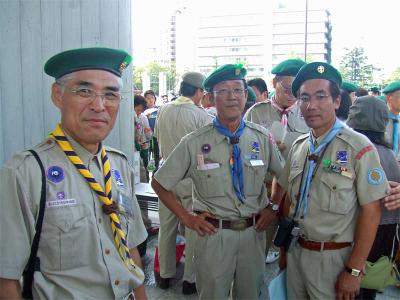
A volunteer table was handing out glasses of water, and when I drank, I saw a sign reminding me that after the bomb, badly burned victims often died in the merciless heat crying out, “Water, water…” So I felt guilty about water.
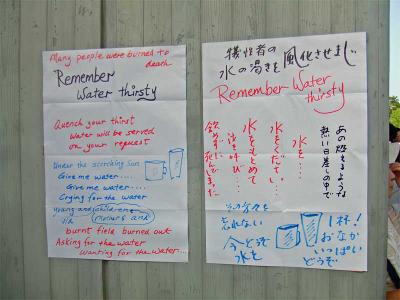
I could hear Prime Minister speaking, but not see him. Then the ceremony was over. I waited in the International Exchange Lounge (with free English books to read) for awhile, then remembered a sign telling people to come to ground zero at 10:00 am. I ran there in the sweltering heat, and saw a crowd of people staring at the sky.
 A helicopter was hovering at the exact spot where the bomb went off and was going to take a picture of us. Some kind of peace project. In the meantime, a boat with some musicians standing on it was just 30 meters from the A-Bomb dome in the river, and the Japanese woman was singing, “What a wonderful world” and “Imagine”.
A helicopter was hovering at the exact spot where the bomb went off and was going to take a picture of us. Some kind of peace project. In the meantime, a boat with some musicians standing on it was just 30 meters from the A-Bomb dome in the river, and the Japanese woman was singing, “What a wonderful world” and “Imagine”.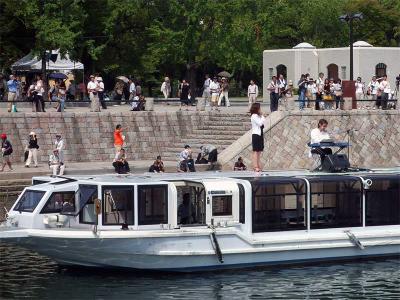
 Are western songs that popular? BTW, these two songs are available on Karaoke in Japan, and I recommend you learn them if you want to sing in English over here.
Are western songs that popular? BTW, these two songs are available on Karaoke in Japan, and I recommend you learn them if you want to sing in English over here.Saw a demonstration of people gathered. But no bad vibes. They were inviting foreigners to come up, for example, one would say, “I’m from Iran.” Then the emcee asked him to chant in Persian for “Peace in Iran. Peace in Iran.” Then they all did it in English. An American came up, and they stared chanting, “Peace in America. Peace in America”. Then "Peace in Korea. Peace in Korea."

Pacifism has truly spread throughout Japan. Very little anti-American sentiment, and more a forward-looking "lets have peace" sentiment. Much of the crowd was visiting all the memorials to the dead and burning incense and saying prayers.
I saw a kamishibai performance. A woman arrived on a bike, and then showed illustrations on card, which she kept revealing like a slideshow. She changed her voice to play different roles, and was quite dramatic in her tellingthe story of Sadako, the girl who inspired the Children’s memorial in the Park.
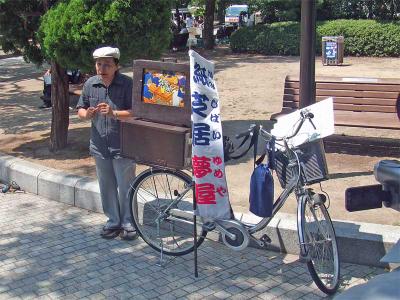 Some 10 meters or so away from her, another group of performers was telling the story of Sadako, this time one played on a wooden cello, and the woman just read from the Sadako book. No Role Playing whatsoever.
Some 10 meters or so away from her, another group of performers was telling the story of Sadako, this time one played on a wooden cello, and the woman just read from the Sadako book. No Role Playing whatsoever. 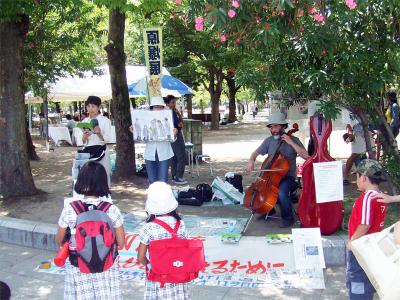
I got soaked with sweat in the unbelievable heat and so headed on back to the station to check my email, and then went off to eat dinner with the family. Then I realized I had no sunscreen, and saw I was sunburned on a little patch of skin. Ouch!

Friday, August 05, 2005
Who is this guy Tamori?
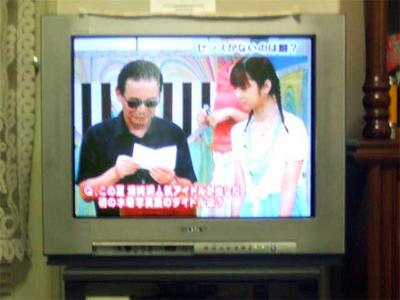
The alarm clock broke again, and so I woke up too late, almost afternoon. That screwed up my sleep schedule, as I wanted to wake up early tomorrow. But interestingly enough turned on the TV and saw Tamori. He is a comedian whose trademark is wearing dark sunglasses. He is on a TV show every weekday afternoon called “waratte ii tomo,” good clean fun for the entire family. But what freaks me out is that last night, when I came home, while channel surfing through late night Japanese TV (which, although there is still no nudity, tends to be a bit more risqué on subject matter than daytime TV), and saw a TV show on the history of adult entertainment in Japan. And who was the emcee, but no other than Tamori himself! Here is a picture I took of him on that adult themed late night show.
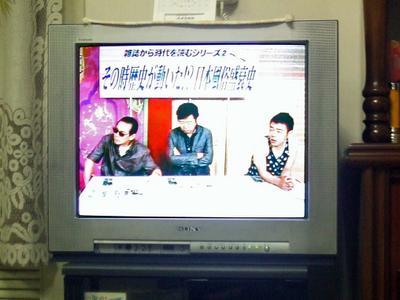 Imagine Regis Philbin on late night TV doing a special like that. I took pictures of the TV last night, and then waited for the afternoon show to come on to give you an idea.
Imagine Regis Philbin on late night TV doing a special like that. I took pictures of the TV last night, and then waited for the afternoon show to come on to give you an idea.As I was about to leave the apartment, I could hear the loud beating of drums. After I threw away the trash outdoors, I saw a procession of people with a cart in tow, and a van that had an inscription in Japanese to protect the pacifist Article 9 of the constitution (which renounces war as an instrument of foreign policy.
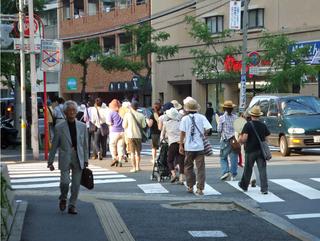 According to the news later that day, it was the Stone walk or something like that according to the news. Peace activists, one of them a 9-11 victim family, participated. I saw her on TV apologize on behalf of Americans for the atomic bombings. Like I said, tell people in Koreatown or Chinatown that you are apologizing for them.
According to the news later that day, it was the Stone walk or something like that according to the news. Peace activists, one of them a 9-11 victim family, participated. I saw her on TV apologize on behalf of Americans for the atomic bombings. Like I said, tell people in Koreatown or Chinatown that you are apologizing for them.Anyway, there have been lots of news specials on the A-bomb, and a very good documentary on why the bomb was dropped. It recreated the debates among top policy makers and showed the split in opinions among American policymakers at the time as to whether dropping the bomb was a good policy. They also showed survivors of the A-bomb telling their very poignant and sad stories. One woman remembered hearing her kids screaming for help from beneath the house that collapsed on them, but she could not rescue them, and had to suffer knowing that the fires would burn them alive.
We all got into a rather animated discussion of the war at dinner, and I pointed out that Japan is not seen as the victim of the war in most parts of Asia. It was a wide-ranging discussion, and could be an emotional topic, so I had to choose my words carefully. People weighed in on their views. I asked why there was so little anti-American sentiment in Hiroshima, and Kazuhiro laughed and said, “It’s because we Japanese are such a fine people.” Aunty told me that probably life was so harsh during the war, and got better under the Americans, so the people have no bitterness. Compare with Iraq, where life has turned terrible for many Iraqis, and so they regard the Americans as occupiers. I found out that Aunty felt angry towards the Soviets the most, as they had a neutrality pact with the Japanese and backstabbed them by entering the war. Also, tens of thousands of Japanese died in Soviet captivity AFTER the war, a fact little known throughout the world.
The news special continued after dinner. It showed a chilling reenactment of the dropping of the bomb using computer graphics. Then they tried some confrontational journalism. They brought in a retired college professor, who was a developer of the atomic bomb, and also a crewmember on a B-29 that participated in the atomic bombing. They had him visit the Peace Park Museum, and then later had him meet two bombing survivors. They demanded an apology from him, and he refused, angrily telling them, “Remember Pearl Harbor” and told the survivors that if they want an apology, they should ask it from the Japanese military who led them into the war. Later on, the younger co-host expressed shock that the man would refuse to apologize for such a horrendous bombing, but the older news host said that outside of Japan, many people feel the bombing justified because of what Japan did in China and Korea.
I walked home and started typing this blog while watching more news. I better go to sleep, but I see on TV a Japanese singer singing live in front of the A-bomb. Maybe I should get minimal sleep and go to the Peace Park.
Anyway, Aunty told me to put a picture of my dead relatives on the blog, so here it is. In Japan, people put a picture of the deceased on a wall next to the Buddhist altar at home so that you will always remember them.

Thursday, August 04, 2005
Tempting fate: midnight walk in the city
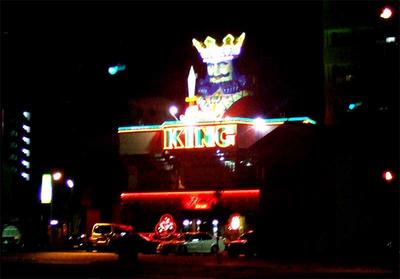
What`s new these days? Spent most of the day working on my manuscript. I feel like an international student again, with so much of my time in front of my laptop (sans internet connection). Now Choco has finally warmed to me, allowing me to hold her for but a second. She ran away after the picture was taken, and is afraid of cameras pointed at her.
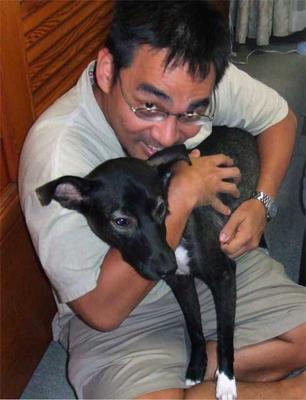 I also took a picture to show those of you back home Kurie`s new haircut. I think the hairstylist did a good job.
I also took a picture to show those of you back home Kurie`s new haircut. I think the hairstylist did a good job.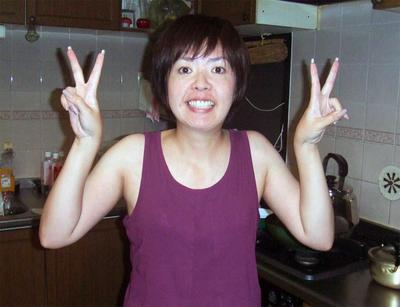
But I did decide to do something rash: go to the Internet café late night and do some work. Yes, I disregarded Aunty`s warnings and decided to walk to the Internet cafe close to midnight.
I passed by a pachinko parlor(picture at the very top): they seem to be all over Japan. It is a pin-ball like game in which you are theoretically supposed to win gifts, but you can exchange your gifts, or tokens for money at a booth outside the game parlor. Hey, techically, you are not gambling, just swapping your prizes for money, right? I took a picture of this statue of a bikini woman outside the pachinko place.

Walking around a station past midnight – I could never do this in America. I saw very few people walking around, and for a moment, I questioned the wisdom of doing this. Maybe Aunty was right. I calmed down after awhile and realized that many Japanese mistook me for a criminal since I speak flawed Japanese, big by Japanese standards, but do not look foreign. The media likes to talk about Chinese criminals, so perhaps that is why some people seem scared of me when I interact with them. Now I kinda know what it is like to be Black in all-white suburbs.
And then I saw the Japanese homeless. They do exist, but you do not see them during the daytime in Hiroshima. Osaka, you do see them at Shinsekai. Or were they drunken salarymen who missed their last train?

Bought a nori bento for only 450 yen, or less than $4.50! Filling, and way better than a McDonald’s value meal (and more nutritious) and perhaps even some plate lunches. Why can’t we make bento with fluffy rice?
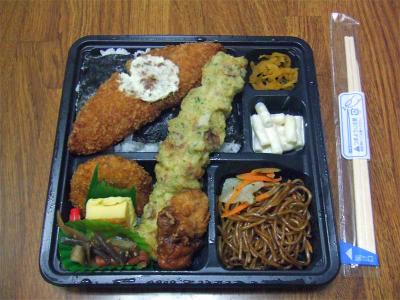
Wednesday, August 03, 2005
Field of Carps

Kazuhiro gave me a call today. “You want to go to a baseball game?”
Now I have seen tons more Japanese baseball games than MLB games. Yes, the players might be faster, speedier, and stronger (and more pumped with steroids) in the major leagues. But all baseball fans should visit a Japanese baseball game to experience a true baseball atmosphere. So I went off to see my favorite team, the Hiroshima Carp battle the Yomiuri Giants, a Tokyo-based team akin to the Yankees of Japan.
About the name, "carp". In Japan, the carp is a symbol of perseverance as a fish that is always fighting to go upstream. But when I was a college student in Minnesota, I found out that the carp was a symbol of junk fish, much like how people in Hawaii view tilapia in the dirty Ala Wai canal. So Americans from the mainland must snicker when they hear the team name is the“Carp”.
Now I love Japanese baseball more than MLB baseball in America. Most of the good Japanese players have left for the Major Leagues, and there are complaints that Japanese baseball is too boring. I beg to differ. First of all, you are not held hostage to expensive and bland stadium food like in America. No, you can bring in food from outside the stadium. So we bought some quality bento from a department store, and, of course, our own beer. And then we constantly heard organized cheering. Each team has its own organized cheering section, and it adds atmosphere to the game.
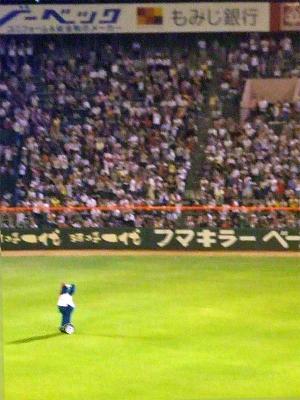 Trumpets would blare, and all would clap with their clappers in unison. Fans would wave gigantic flags, and cheer the name of the person at bat. Fans would also stand in unison, this section stands up and chants, and then that section stands up and chants. For every hit or strikeout or similar fine play, they would do a chant to congratulate the player.
Trumpets would blare, and all would clap with their clappers in unison. Fans would wave gigantic flags, and cheer the name of the person at bat. Fans would also stand in unison, this section stands up and chants, and then that section stands up and chants. For every hit or strikeout or similar fine play, they would do a chant to congratulate the player.I also heard trumpets recycling long-forgotten American music from the 1970s. I kept hearing trumpets and fans chanting in Japanese to the Village People’s “Go West,” and even the opening line of 1970s disco classic Jigsaw’s “Sky High.” You know the one that goes, “Blown…(blown blown blown)…rooound like the wind”. Like I said, the Japanese keep alive traditions long discarded in the U.S. The stadium did play a clip from “My Sharona” and Queen’s “We will Rock You” to add some atmosphere to the games. Kazuhiro told me that the Giants rooting section played and sang along to “Go West” because it was the favorite song of one of the Giants players.
As usual, the Japanese fans love costumed creatures. “Slyly” is the name of the Hiroshima Carp mascot and looks like a mutant variety of the Philadelphia Phillies mascot.
 If it were up to me, I would create a giant carp costume, and have the mascot be a batting carp. Still, Slyly proved to be very popular. Kids eagerly ran up to Slyly and young office women giggled as they pulled out their cell phone cameras to pose with him/her/it. The Carp have also adopted an American idea – have a dog deliver the balls to the umpire. Mickey, the “baseball dog” wasn’t here today, but a stadium announcement said the dates when the golden retriever would be in the stadium. According to the TV news, he even has his own baseball card. And you see that..ahem...sausage shaped balloon in the picture. Well in the 7th inning (lucky seven) the fans blow up these balloons and release them all at once.
If it were up to me, I would create a giant carp costume, and have the mascot be a batting carp. Still, Slyly proved to be very popular. Kids eagerly ran up to Slyly and young office women giggled as they pulled out their cell phone cameras to pose with him/her/it. The Carp have also adopted an American idea – have a dog deliver the balls to the umpire. Mickey, the “baseball dog” wasn’t here today, but a stadium announcement said the dates when the golden retriever would be in the stadium. According to the TV news, he even has his own baseball card. And you see that..ahem...sausage shaped balloon in the picture. Well in the 7th inning (lucky seven) the fans blow up these balloons and release them all at once.Now it is said that sports is a reflection of society. For example, in Europe and in America, fights break out between opposing fans. In the U.S., you need to have security guards everywhere. Here in Japan, there seemed to be an unwritten rule. Giants fan could root when their team is at bat. I heard no boos from the Carp side. Then the Carp fans would root when their team was at bat. I heard no catcalls or snide comments from the audience (then again, Hiroshima fans could be well behaved but I noted the same behavior in Tokyo).Here is a picture of a whole section of salarymen in the stands with their suits taken off.
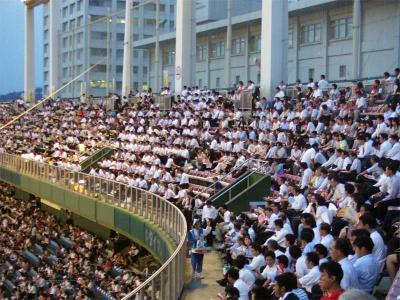 So why do we Americans wonder when our youth get into fights and such. Hello, but do we adults not encourage booing from the student section at games? In Japan, if you don’t like the other team, you remain SILENT. Booing is just too low class.
So why do we Americans wonder when our youth get into fights and such. Hello, but do we adults not encourage booing from the student section at games? In Japan, if you don’t like the other team, you remain SILENT. Booing is just too low class.And I noticed that the fans behaved themselves perfectly. I saw almost no policemen and the security guards were reed-thin college students. It would probably take four of those guards to hold back a drunken blalah in Hawaii. And yet, no problems when the Giants fans kept chanting and cheering, even after the game was over. European and American fans would consider this to be rubbing it in. And then the fans cleaned up after themselves, and carried their trash out to the main trashcan by the exit. On the way out, we saw the bus with the Giants players stop in front of us. A whole crowd of Carps fans, some wearing Carp shirts, pulled out their cell phone cameras and started taking pictures of the Giants players. Talk about team loyalty.
And yes, it was humidly hot. So humid that I was soaked with sweat when I returned home.


